The vast, magnificent universe of stars, galaxies, and time itself has an expiration date—and it may come far sooner than once thought. A team of Dutch researchers from Radboud University has proposed that the universe could decay in roughly 10⁷⁸ years, compared to the previously believed 10¹⁰⁰ years. Their conclusion stems from a bold reinterpretation of Hawking radiation.

Originally, Hawking radiation described black holes emitting faint energy due to quantum fluctuations, suggesting they could slowly evaporate. But physicists Heino Falcke, Michael Vendrell, and Walter van Suijlekom have expanded this idea. They suggest Hawking-like radiation applies not only to black holes but to any massive object with a gravitational field—white dwarfs and neutron stars included.
Their calculations revealed that white dwarfs, long thought to last 10¹⁰⁰ years, would instead vanish in just 10⁷⁸ years. Even neutron stars and stellar black holes decay in about 10⁶⁷ years—nearly the same, despite the stronger gravity of black holes. Why? Black holes lack a surface, allowing them to reabsorb some radiation and slow down decay.
This reframes how we see the end of the universe. No matter how dense or massive, all objects will eventually evaporate. Density slows decay, but nothing is immune. Even the Moon or a human body, under idealized conditions, would evaporate via this process—in about 10⁹⁰ years.
By applying this universal radiation concept, the researchers compress the universe’s long goodbye into a much shorter timeline. The degenerate era—the final age of white dwarfs and neutron stars—is significantly shorter than once believed. The black hole era is also cut short, as stellar black holes won’t last as long as previously thought.
Beyond changing the cosmic calendar, the implications are profound. This work may help bridge the gap between quantum mechanics and general relativity. By showing quantum effects like radiation extend beyond black holes, it hints that spacetime itself may be fundamentally quantum. This could provide a new path toward a theory of quantum gravity.
Ultimately, this research reshapes our view of the cosmos—from its distant future to the fabric of reality itself. In a universe destined to fade, wonder remains. With every discovery, we get closer to understanding not just the end—but the nature of everything in between.
Author: https://arxiv.org/pdf/2410.14734 NASASpaceNews
